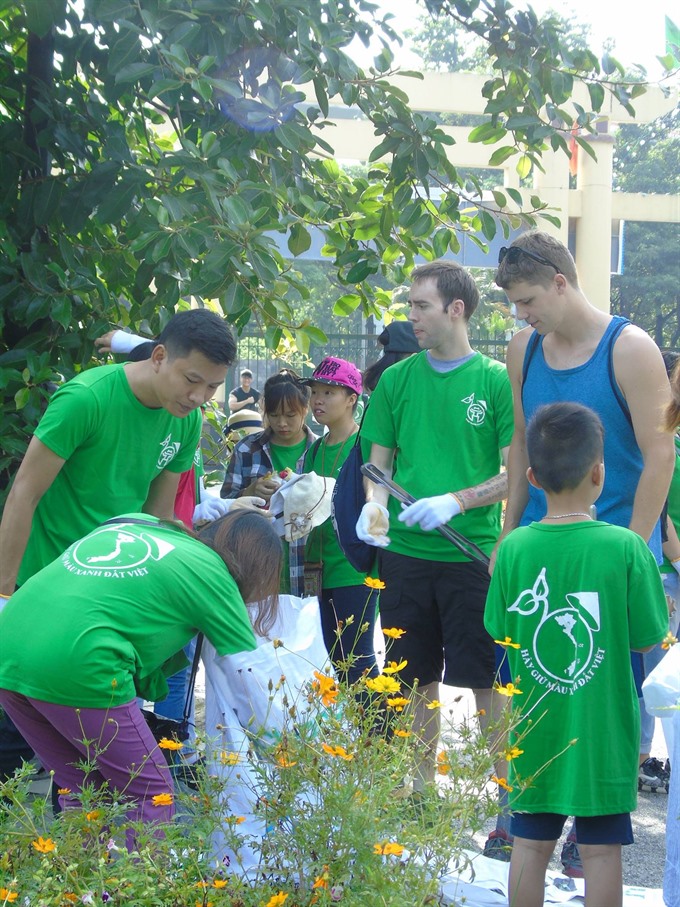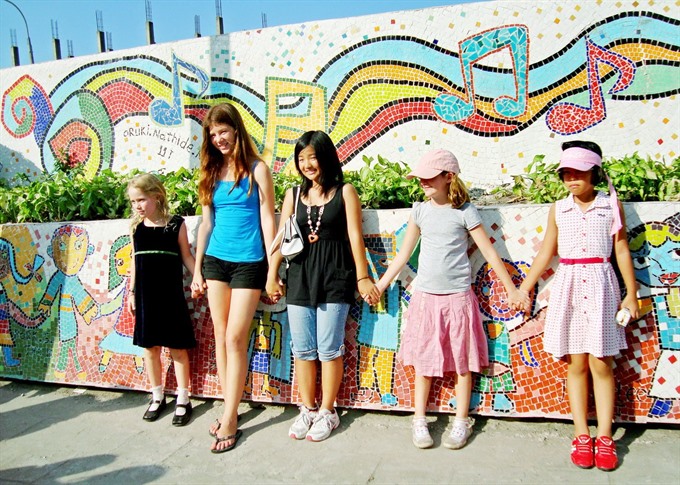 Features
Features

After 10 years, the Bùi Xuân Phái Award has become an important touchstone in the country’s socio-political and cultural development. Minh Đức reviews.
 |
| Clean and green: The group Keep Hà Nội Clean initiated by US citizen James Joseph Kendall received the Bùi Xuân Phái Award in 2016 for their contributions to environmental protection in the city. — Photo courtesy of the Keep Hà Nội Clean group |
"The Ceramic Road" along the Red River has adorned Hà Nội like a colourful ribbon seven years since it was inaugurated to mark the capital city’s millennial celebrations.
The project to build the "Ceramic Road" was initiated by painter Nguyễn Thu Thủy, who received the first Bùi Xuân Phái – For the Love of Hà Nội Award in 2008.
The Award was created by the Vietnam News Agency (VNA)’s Thể thao Văn hóa (Sports & Culture) newspaper to honour outstanding artists, authors and scholars who base their works on the beauty and charm of the capital city.
The Award is named after renowned painter Bùi Xuân Phái (1920-88) whose iconic works on the capital city have achieved global fame. Through 10 seasons, the Award has honoured the contributions of many Vietnamese and foreign individuals and organisations to society, culture and the arts in Hà Nội.
To this day, the award winners’ works and values continue to fulfill the mission of adding beauty, charm and culture to the capital city.
"The Ceramic Road", done by artist Thủy and her colleagues, is a prime example.
The project started in 2007, decorating the walls of the Red River dyke with colourful tiles depicting many themes. It was inaugurated in 2010 to celebrate the 1,000th anniversary of Hà Nội, espousing the idea of invigorating urban Hà Nội and bringing local communities together through public art.
It earned the city a place in the Guinness World Records with the world’s largest ceramic mosaic.
At the outset, The Ceramic Road was 3.85km long, but this has since expanded to a 6km-long mural featuring 35 professional artists from Việt Nam and 10 foreign countries, and over 100 artisans from traditional ceramic villages, as well as children and students from fine arts colleges in the country.
Thủy said the artists are very proud to have been awarded a Guinness World Record.
“The project of building the Ceramic Road was an ideal way to commemorate the city’s millennial anniversary,” she said.
“We are so happy that the work brings pride to Hà Nội and that the people of the city enjoy the mural’s beauty for many years to come.”
“The integration of international artists and children’s art depict many different moods, cultures, eras of history and styles, and they have all been created with the greatest craftsmanship.”
However, many parts of the Ceramic Road have been damaged due to vagaries of the weather and irresponsible actions of people. Thủy said the municipal departments of culture and construction should join hands to repair and maintain the work more regularly. The most recent restoration work took place two years ago.
The Ceramic Road project transformed the Red River dyke, which used to be covered with illegal graffiti and commercial advertising.
It even inspired residents of Hà Nội to create more murals to beautify their living spaces. With their own money, residents of Lane 78, Duy Tân Street, built a 200m-long ceramic mural showing familiar images of the capital such as the Temple of Literature, Ngọc Sơn Temple and Thê Húc Bridge.
It was an effective way to prevent advertisements being glued on walls and to make it a sightseeing spot.
Another Bùi Xuân Phái Award recipient, the Old Quarter’s pedestrian streets, have now become a cultural hub for residents and foreign tourists. Thousands throng the area to listen to music, drink beer and have fun.
The pedestrian streets area is also the rendezvous for members of the Hoàn Kiếm Chess Club.
“Thanks to the pedestrianised streets, we have a place to share our hobby and we hope to promote Vietnamese culture through chess,” said Lưu Đức Hải, head of the club.
“People of different ages and nationalities gather here every weekend to express their passion for chess.”
A tourist from the US, Jarrah McCue, said it was a wonderful community activity and he was excited to join though he was defeated by a highly capable opponent.
VNA Director General Nguyễn Đức Lợi said that after 10 years of establishment, the Bùi Xuân Phái Award had affirmed its role and position in the country’s social, political and cultural spheres.
The Award are classified into four categories: Grand Prize, Idea Prize, Job Prize and Work Prize.
Previous winners of the Grand Prize are: Nguyễn Vinh Phúc, a scholar specialising in Hà Nội research (2009), writer Tô Hoài (2010), Prof Phan Huy Lê (2011), guitarist Văn Vượng (2012), and photographer Quang Phùng (2013).
Many foreigners have also received the Award, including UK diplomat John Ramsden for his photo collection capturing the life of Hà Nội during the 1980s, French researcher Olivier Tessier, chief of the Hà Nội-based Ecole Francaise d’Extreme-Orient (French School of Asian Studies), for his research on Hà Nội’s Ancient Citadel, Uruguay author Martin Rama for the book Hà Nội, Một Chốn Rong Chơi (Hanoi, Promenade), James Joseph Kendall, a US national, and the Keep Hà Nội Clean team for their contributions to environmental protection in the city, and French singer and musician La Grande Sophie, who wrote the Hà Nội song. — VNS
 |
| Space to stroll: Another Bùi Xuân Phái Award recipient (2017), the Old Quarter’s pedestrian streets, have now become a cultural hub for residents and foreign tourists. — Photo zing.vn |
 |
| Sightseeing spot: Tourists pose in front of the Ceramic Road, the recipient of a Guinness World Record, in Hà Nội. The work received the Bùi Xuân Phái Award in 2008. — Photo mytour.vn |